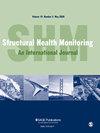Detection and evaluation of heat damage in reinforced concrete beams using linear and nonlinear guided waves
IF 5.7
2区 工程技术
Q1 ENGINEERING, MULTIDISCIPLINARY
Structural Health Monitoring-An International Journal
Pub Date : 2023-11-07
DOI:10.1177/14759217231203022
引用次数: 0
Abstract
This study utilizes the linear and nonlinear features of guided waves (GWs) for detecting and evaluating heat damage in reinforced concrete (RC) beams. The RC beams with embedded sensors attached at rebar ends are experimentally studied using longitudinal GW at 200 kHz after heating the specimens in a furnace from 100°C to 300°C. For the studies investigating the effect of heat damage on the RC beams beyond 300°C, the rebar ends are exposed outside the concrete so that the longitudinal transducers can be attached there. These specimens are then experimentally studied using GW with an excitation frequency of 100 kHz. In this study, the RC beams are prepared as fully bonded and debonded specimens. The experimental study shows that heat damage in the RC beams causes debonding between rebar and concrete enabling GW signal to generate second harmonics. The experimental study also discussed the linear features of GW, which shows that the amplitude of the GW signal increases with elevated temperatures in the RC beams. To distinguish material nonlinearity and contact nonlinearity, two types of nonlinear parameters are defined in this study. The nonlinear parameter due to the contact acoustic nonlinearity effect in the RC beams is defined as β, whereas the nonlinear parameter due to material nonlinearity is defined as β m . The study shows that β m is negligible in comparison to β at relevant heated temperatures. With the increase in temperature, the nonlinear parameter β is significantly increased at elevated temperatures. The peak amplitude of the nonlinear parameter β is observed at the maximum heated temperature 800°C for both bonded and debonded specimens.基于线性和非线性导波的钢筋混凝土梁热损伤检测与评价
本研究利用导波(GWs)的线性和非线性特征来检测和评估钢筋混凝土(RC)梁的热损伤。在100 ~ 300℃的加热炉中加热后,采用200 kHz的纵向GW对钢筋端部嵌入传感器的RC梁进行了实验研究。对于研究超过300°C的RC梁的热损伤影响的研究,钢筋末端暴露在混凝土外部,以便纵向传感器可以附着在那里。然后用激励频率为100khz的GW对这些试样进行实验研究。在本研究中,RC梁被制备为完全粘结和去粘结试件。试验研究表明,钢筋混凝土梁的热损伤会引起钢筋与混凝土之间的脱粘,使GW信号产生二次谐波。实验研究还讨论了GW信号的线性特征,表明在RC梁中,随着温度的升高,GW信号的幅度增大。为了区分材料非线性和接触非线性,本研究定义了两类非线性参数。RC梁中由于接触声非线性效应引起的非线性参数定义为β,而由于材料非线性引起的非线性参数定义为β m。研究表明,与相应加热温度下的β相比,β m可以忽略不计。随着温度的升高,非线性参数β显著增大。在最高加热温度800℃时,粘结和脱粘试样的非线性参数β均出现峰值。
本文章由计算机程序翻译,如有差异,请以英文原文为准。
求助全文
约1分钟内获得全文
求助全文
来源期刊
CiteScore
12.80
自引率
12.10%
发文量
181
审稿时长
4.8 months
期刊介绍:
Structural Health Monitoring is an international peer reviewed journal that publishes the highest quality original research that contain theoretical, analytical, and experimental investigations that advance the body of knowledge and its application in the discipline of structural health monitoring.

 求助内容:
求助内容: 应助结果提醒方式:
应助结果提醒方式:


